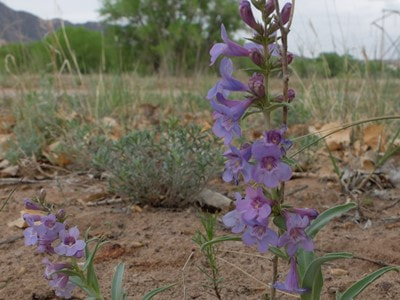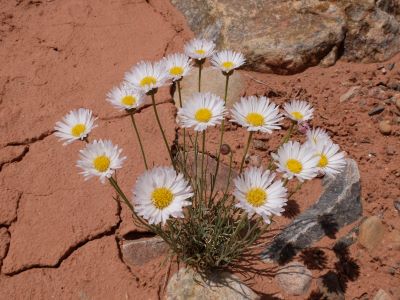|
Found in sandy areas, vacant lots, roadsides
Seen blooming in May near Arroyo Trujillo Penstemon is a genus of about 250 species. The flowers are tubular with two lips; the upper lip is two-lobed and the lower is three-lobed. The common name beardtongue comes from the long, hairy stamen which extends from the throat, like a fuzzy tongue from an open mouth. Narrow-leaved Penstemon grows between 1 and 2 feet tall with stout stems and fleshy, narrow leaves which have a lighter-colored mid-vein. Stems and leaves are light green and hairless. The flowers are lavender to bright blue and grow all around the stem. The beardtongue has orange hairs on its tip. The Lakota people used the flowers to make blue dye for painting moccasins. If you trying to identify a different flower then you can check what other flower bloom this month. If you cannot identify a flower from the website, send a photo and where you took it to [email protected]. Read online for tips.
0 Comments
Basin Fleabane, Basin Daisy, Beautiful Daisy,Erigeron pulcherrimus,Sunflower Family (Asteraceae)5/21/2021 Found in dry, silty areas, piñon-juniper
Seen blooming in May in Red Wash Canyon Pulcherrimus means extremely beautiful and this daisy is certainly that. It grows in dense clumps to 12 inches high with narrow, mostly basal leaves. There is only one flowerhead on a stem. Flowers are one inch across with a yellow disk and curling petals which can be white to pale lavender. Daisies are also called Fleabanes. Some early American settlers kept dried fleabane in their homes and in small satchels to repel gnats and fleas, which is how the plant got its common name. In fact, there is no evidence that supports fleabane as an insect repellent. Source. If you trying to identify a different flower then you can check what other flower bloom this month. If you cannot identify a flower from the website send a photo and where you took it to [email protected]. Read online for tips. Found in rocky, sandy soils, sagebrush, woodlands
Seen blooming in May at Abiquiú Lake This is a DYC, a damn yellow composite, akin to an LBB in birdwatching lingo. The Sunflower family, Asteraceae, is sometimes called the Composite family and consists of about 2,400 species in North America. Many of them are yellow and share a unique flower structure. The flower head is actually composed of many small flowers packed tightly together; central disk flowers surrounded by ray flowers, the petals. Some species have only ray flowers, like the Dandelion, or only disk flowers, like Hopi Tea. Lobeleaf Groundsel has both and grows up to 16 inches high with a few purplish stems and distinctive, mostly basal, deeply cut leaves. Flowers are small but numerous with a yellow disk and 8 to 13 yellow petals. Two other DYCs blooming this week are Perky Sue and Sowthistle Desert Dandelion. Traditionally, a decoction of the plant is used by the Navajo for menstrual pain. The Yavapai inhaled a decoction of the stem for colds and for sore noses, and took a decoction of the root for stomachache. Source. If you trying to identify a different flower then you can check what other flower bloom this month. If you cannot identify a flower from the website send a photo and where you took it to [email protected]. Read online for tips. Found in moist areas, on river banks
Seen blooming in May in Abiquiú You have all seen the huge cottonwoods that grow along the ditches and the Rio Chama, and in its historic floodplain, but the flowers high above your head may not be so familiar. This is the red male flower, called a catkin, loaded with golden pollen. Male and female flowers grow on separate trees and emerge before the leaves. When the less conspicuous green female flower is pollinated the green seedpods hang like a small bunch of grapes before they explode and fill the air with cottony seeds. Cottonwoods can grow to 100 feet tall, more usually 50 feet, with leaning trunks up to 5 feet in diameter, wide-spreading branches and a leafy canopy. Mature trees have thick, deeply-furrowed, gray bark. Leaves are glossy green and triangular. They turn bright, golden yellow in the Fall. Native Americans used various parts of the tree; inner bark was often dried, ground into a powder and then used as a thickener in soups etc. or added to cereals when making bread, catkins are eaten raw, and the cotton and buds have been used by children as a chewing gum. The wood is used to make various items and for fuel. Source. If you trying to identify a different flower then you can check what other flower bloom this month. If you cannot identify a flower from the website send a photo and where you took it to [email protected]. Read online for tips. |
AuthorI am Marilyn Phillips, a native of England, whose love of nature and the outdoors from childhood brought me by a circuitous route to Crested Butte, Colorado in 1993 and 16 years later to northern New Mexico. My exploration of the many trails in these areas, my interest in wildflowers and photography, and career in computer system design came together in this creation. If you have any corrections, comments or questions, please contact me by email. Archives
September 2025
Categoriescopyright © 2020
|






 RSS Feed
RSS Feed